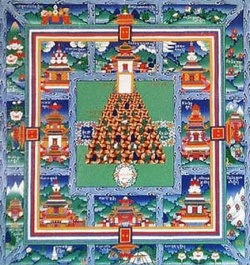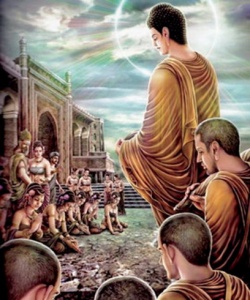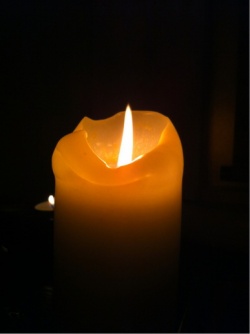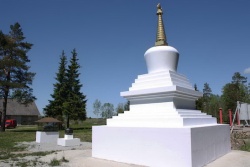Arguing for Saichō's Monastic Model
A discussion between Malcolm and I over at www.dharmawheel.net (Malcolm's statements are in italics):
Prātimokṣa vows are the basis of bodhisattva vows.
No, it is the other way around in Mahāyāna. The prātimokṣa vows were provisionally established due to problematic circumstances during the Buddha's lifetime. The bodhisattva precepts are taught by all buddhas.
Chronologically your statement above makes no sense because the bodhisattva precepts are recited by the bodhisattvas and buddhas of the past, present and future. The Brahma Net Sūtra states:
The Buddha said, "All of you disciples! These are the Forty-eight Secondary Precepts that you should observe. Bodhisattvas of the past have recited them, those of the future will recite them, those of the present are now reciting them.
"Disciples of the Buddha! You should all listen! These Ten Major and Forty-eight Secondary Precepts are recited by all Buddhas of the Three Periods of Time -- past, present, and future. I now recite them as well."
http://www.sinc.sunysb.edu/Clubs/buddhism/bns/bnsframe.htm
Consequently your statement "prātimokṣa vows are the basis of bodhisattva vows" is refuted.
Without one, you cannot have the other.
Prātimokṣa precepts are encompassed within the bodhisattva precepts, which comprise the three sets of pure precepts:
1. Precepts for restraint or discipline (saṃvara-śīla).
2. Precepts for the practice of all virtuous deeds (kuśala-dharma-saṃgrāhaka-śīla).
3. Precepts for the benefit of all beings (sattvârtha-kriyā-śīla).
That being said, the the Vinaya prātimokṣa does not encompass the latter two. It only restrains the practitioner from misdeeds and socially inappropriate behavior. For instance, in the Mahāsāṃghika Vinaya the bhikṣu is permitted to let a woman drown to death and say it is her karma rather than rescue her. With bodhisattva morality this would be a violation. The bodhisattva is obligated to save lives.
A person who follows upāsakā prātimokṣa and bodhisattva vows is still just an upāsakā. A person who follows śramaṇera prātimokṣa is still just a śramaṇera.
This is strictly speaking an orthodox Vinaya view, which is valid within the context of Śrāvakayāna. That being said it does not apply to the Japanese sangha because the sangha council in the early Heian period approved Saichō's reforms whereby a renunciate bodhisattva received alternative precepts based on bodhisattva precepts which granted him the status of a bhikṣu.
For further details see the following:
https://sites.google.com/site/dharmadepository/writings/saichos-reforms
There is a great deal of Indian writing, as well as Tibetan writing on the subject of the three vows.
There is vast literature in China and Japan as well. I tend to agree with many authors of ancient times who argued for the superiority of bodhisattva precepts.
When śramaṇeras or bhikṣus opines in public that their vows are not important, this leaves a very bad impression on lay people, and causes lay people to suspect (correctly) that the Sangha is degenerate and no longer worthy of respect (and so it seem to me). If one claims that only Mahāyāna vows important, than wearing robes truly is a farce, since Mahāyāna vows are the same whether one is a lay person or an ordained person.
You don't seem to know about or appreciate the fact that a celibate and orderly monastic model based on bodhisattva precepts was devised by Saichō and approved by the Vinaya-based sangha authorities in ancient Japan, thereby making it a valid and quite legitimate reform.
...
So was pratimokṣa.
Every Buddha recites pratimokṣa as well. Not every Buddha institutes a bhikṣu Sangha however.
You are mistaken. The first three of the seven past buddhas (Vipaśyin, Śikhin and Viśvabhū) never established any precepts as there was no need.
You cannot take bodhisattva vows without first going for refuge; since going for refuge automatically entails receiving pratimokṣa vows, your refutation is dismantled without the need to resort to scripture.
Prātimokṣa precepts like the five precepts which come with the refuge vows are not the Vinaya. You cannot equate refuge precepts and the five precepts with the Vinaya. The Vinaya prātimokṣa was only provisionally established given the circumstances of the time. The Vinaya is not universal.
Yes, such "monks" are merely celibate lay persons.
Not so. The sangha officially condoned the reform, which is in line with the Vinaya regulations which permit modifications where necessary. As we know, the Buddha stated that the sangha could abandon minor precepts. The Mahīśāsaka Vinaya also states, "Even if it be something I have prohibited, if it is not considered pure [conduct] in other lands, then it all should not be adopted. Even if it is not something I have prohibited, if something must be carried out in other lands, then it all must be carried out.'"
Of course the bodhisattva samvara is "superior" to pratimokṣa vows; nevertheless they cannot be received without first going for refuge, and the receipt of the upāsakā vows is an automatic consequence of going for refuge whether it is first done in a Mahāyāna based rite of conferring the Bodhisattva trainings or not.
This is not necessarily so. You can have refuge precepts without taking the five precepts. Moreover, the upāsaka precepts are not the Vinaya strictly speaking. The "Bodhisattva Vinaya" in the Tendai system is a heavily revised Vinaya system that effectively replaces the Śrāvakayāna model, though bhikṣu precepts are only provisionally taken after an appropriate period of Mahāyāna training, though in practice they may be dispensed with altogether, as was what happened in Japan. This is actually in line with the Lotus Sūtra. It states:
(Bodhisattvas) also do not go near those bhikṣus, bhikṣunis, upāsaka (laymen) and upāsikā (laywomen) who seek [to become] śrāvakas. They also do not enquire after their health [as a salutation]. If they be in a room, on a terraced walk or in a lecture hall, they will not remain together with them [the aforementioned bhikṣu, bhikṣunis, etc.]. If at some time they should come, the dharma will be taught as appropriate without anything being desired.
The Śrāvakayāna Vinaya is effectively pursuing the goal of arhatship in principle, which is why it is appropriate that a bodhisattva may "manifest the marks of a renunciate" and follow their own appropriate monastic model.



